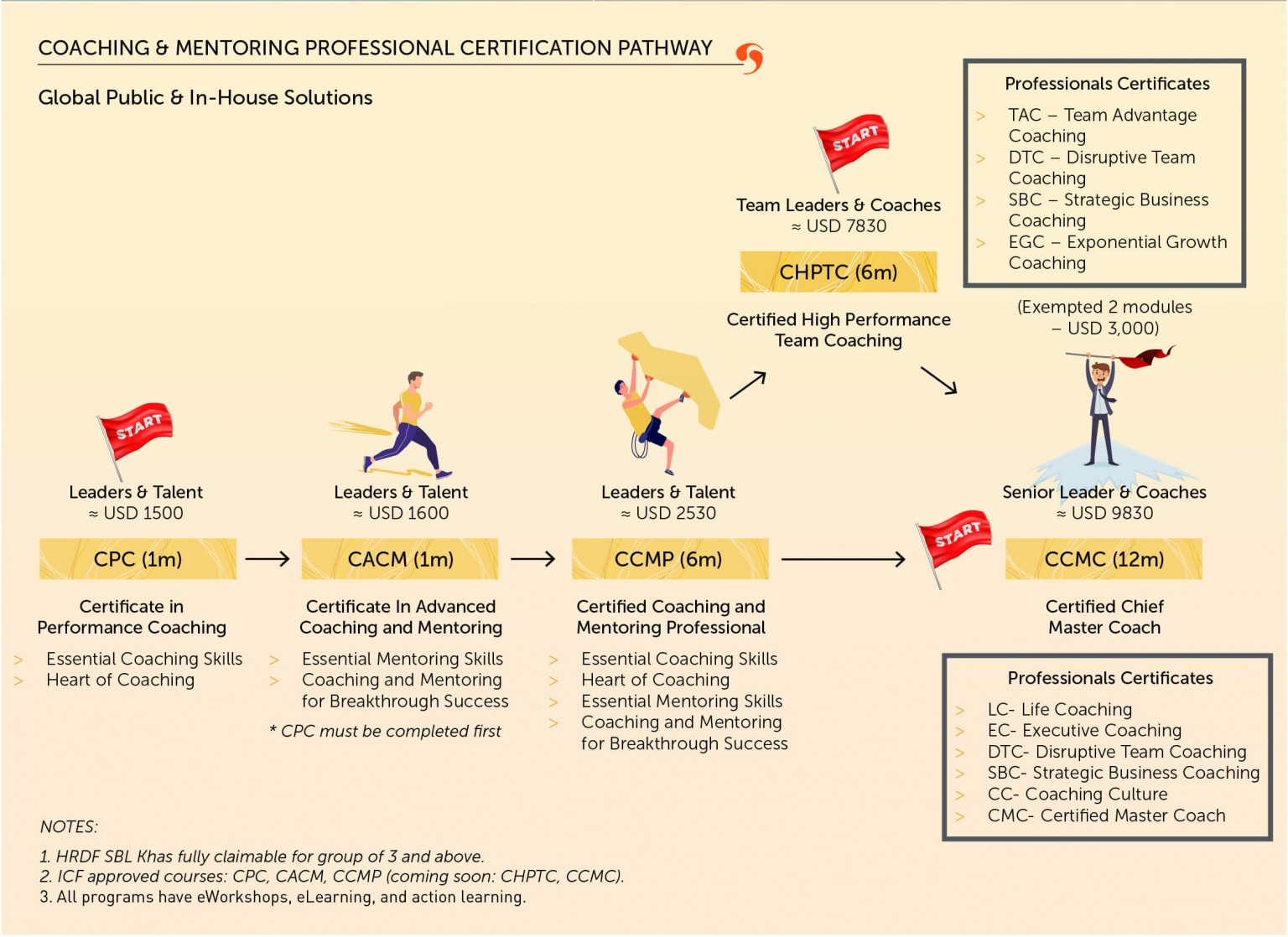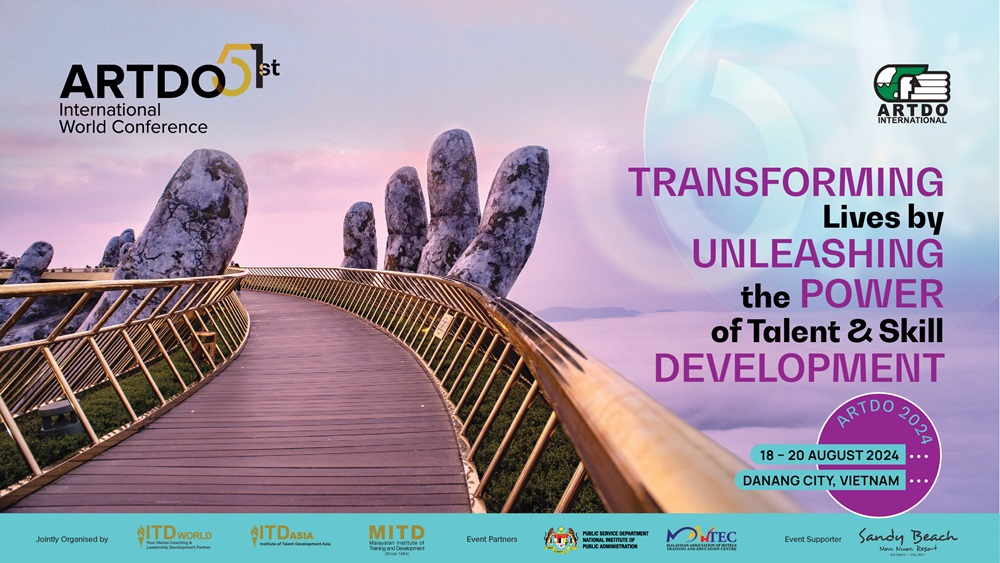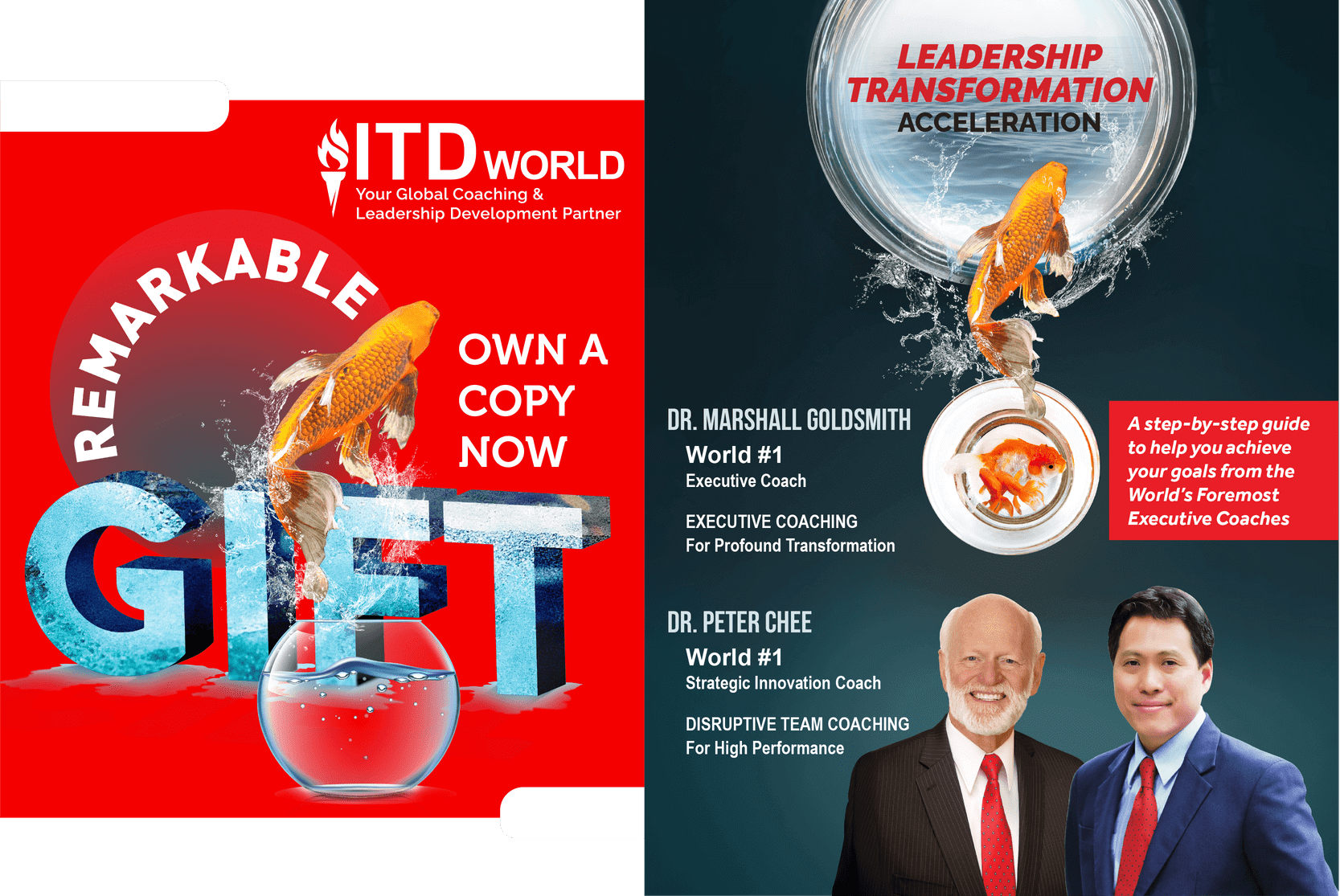Among the fast-paced, ever-evolving landscape of today’s world, unlocking and harnessing the full potential of human talent has become an imperative for both individuals and organizations. Coaching is a transformative force for this purpose, offering a powerful catalyst for personal and professional growth.
(by Aaron Ngui)
What is Coaching?

Coaching is all about bringing people to where they want to go in life and work. It is the process of drawing out solutions from people – so that their potential is realized and unleashed. In a coaching conversation, the coach does not provide the solution or even, suggestions, unless expressed permission is obtained. Instead, various techniques are utilized to empower the person being coached to come up with their own answers.
According to the International Coach Federation (ICF), coaching is defined as “partnering with clients in a thought-provoking and creative process that inspires them to maximize their personal and professional potential. The process often unlocks previously untapped sources of imagination, productivity, and leadership.”
At ITD World, our CEO and World #1 Strategic Innovation Coach – Dr. Peter Chee, together with World #1 Success Expert Dr. Jack Canfield, have defined it as follows:
Coaching is an empowering process of unleashing human potential by drawing out solutions from people through effective listening, asking great questions, using feedback, appreciating and continuously supporting people to take ownership and be accountable for taking action to realize their goals.
History of Coaching
The word “coaching” has its origins in the 16th century, initially referring to a mode of transportation – the horse-drawn carriage. It traces its roots to the Hungarian word “kocsi,” which denoted a carriage produced in the village of Kocs, known for its high-quality carriages. At this stage, coaching was associated with the physical act of transporting individuals.
Over time, the term underwent a metaphorical transformation – it started to symbolize the process of guiding people in their personal and professional development. Its first recorded use in the context of an instructor or trainer occurred around 1830 at Oxford University. In this academic setting, a “coach” was a tutor who metaphorically “carried” a student through their exams, providing them with guidance and support.
The concept later expanded further when it made its way into the realm of sports. The first documented use of “coach” in relation to sports occurred in 1861. Sports coaching became instrumental in enhancing the performance of athletes and teams, setting the stage for coaching’s influence in other fields.
Coaching continued to evolve and diversify during the 20th century. It extended its impact beyond sports and began to shape various other domains, including performing arts, business, education, health care, and relationships. Professionals in these fields gradually recognized the value of coaching in facilitating personal and professional growth, as well as enhancing performance.
Around the 1970s. coaching took root as a distinct profession. It was heavily affected by a confluence of factors, including adult education, the Human Potential Movement, leadership studies, personal development, and psychology. These diverse influences contributed to the development of structured methodologies and practices.
The University of Sydney offered its first coaching psychology unit in 2000, marking a significant milestone in the formalization of coaching as a field of study. Over the years, coaching has continued to grow and diversify. Various types and styles of coaching have emerged, each tailored to specific needs and objectives.
Benefits of Coaching

Coaching breeds accountability, and accountability breeds accomplishments.
- Drive personal transformation
Coaching has many benefits – one of which is its impact on transforming behaviors and habits positively to visualize the changes one desires in life. This is done when the coach helps the person being coached leverage on their strengths, talents, and passions to drive transformation. They do so by engaging in conversations where asking great questions triggers creativity and an exploratory process. The coachee is then prompted to discover and tap deeply into key motivators for attaining their desired outcomes.
- Define a plan for change
The specific key goals and steps defined in the conversation are then converted into a personalized plan for massive action. This record is a key document in keeping the coachee accountable as it records their commitment toward the change they are striving for.
People become highly motivated when they have a sense of deep accountability toward results and are supported by systems that drive them forward. In moving for the desired outcomes, they generate higher influence for a bigger impact on the organization and stakeholders.
Read more: 5Cs of Effective Accountability Partners
- Enhance self-awareness & leadership capabilities
As mentioned, coaching enables people to gain a deeper, more holistic understanding of themselves, including their strengths, weaknesses, values, and beliefs. This self-awareness becomes the foundation for improved decision-making and leadership abilities such as leading by example and inspiring others.
- Improve interpersonal skills
Effective coaching often provides coachees with plenty of opportunities to express themselves more clearly, actively listen to others, and navigate complex interpersonal situations with greater ease. As such, they become more adept at communicating with others, handling difficult people, and resolving internal conflicts for a more harmonious workplace.
Those who give and receive coaching are at a great advantage compared to those who don’t.
Dr. Jack Canfield & Dr. Peter Chee – Coaching for Breakthrough Success
The Importance of Coaching in the Workplace
Coaching plays a pivotal role in shaping a thriving and dynamic workplace environment. It impacts both employees and leaders in various ways – including:
- Bridging education and workplace experience
Coaching serves as a crucial bridge that connects formal education to practical workplace experience. While traditional education equips individuals with technical knowledge, coaching focuses on refining soft skills like presence, communication, and influence – which are essential for effective interpersonal relations and overall team functioning.
As employees enhance their soft skills through coaching, they become more engaged and productive. Improved performance in their current roles opens up doors for career advancement, benefiting both the individual and the organization.
- Fostering trust, collaboration, and empowerment
By involving team members in decision-making processes and problem-solving activities, coaching instills a culture of trust, collaboration, and empowerment within the workplace. When people feel valued and heard, their motivation and engagement levels soar; as such, they are more likely to take ownership of their work and perform at their best. This not only benefits themselves – but also leads to enhanced team dynamics and overall performance.
- Enhancing leaders’ effectiveness and influence
Effective leadership is pivotal to the development of any organization. Coaching equips leaders with a diverse set of skills and techniques – including communication, delegation, and team building – in order to navigate the complexities of a rapidly changing business landscape. As leaders become more effective, their ability to drive the organization toward its goals and vision also goes up significantly.
- Facilitating organizational change and innovation
In a world marked by constant changes, coaching encourages organizations to adopt a learning-oriented mindset. As a result, people are empowered to create and share best practices, fostering a culture of continuous improvement. By unlocking the potential of the workforce, coaching enables team members to generate new ideas and solutions – which is crucial for positioning the company as a market leader capable of adapting to emerging challenges and opportunities.
- Building up a more positive work culture
Coaching contributes to the transformation of workplace culture by promoting open communication, collaboration, and support among team members. When employees feel supported and valued, they are more likely to be happy and productive at work, as well as less inclined to engage in conflicts and absenteeism.
- Attract & Retain top talent
Given today’s competitive job market, attracting and retaining top talent is a critical challenge for organizations. Coaching provides employees with the support and development opportunities they need to thrive in their roles. Engaged and motivated employees are less likely to seek employment elsewhere, reducing turnover rates.
Various research has proven the power of adopting a coaching leadership style in the workplace. An example is one published by Harvard Business Review – which shows that 40% of organizations that practice coaching in Human Resource Management have reported a much higher rate of talent retention compared to others.
Managers who use influence and integrity to empower people are the ones who become truly respected coaching leaders.
Coaching vs Mentoring – The Differences
Organizations and corporations make use of both coaching and mentoring to accelerate performance for sustainable success. The adoption of these two approaches to developing talent has grown tremendously as businesses seek ways to optimize their human resource capital.
Although the two terms are often used interchangeably, they are fundamentally different in their methods.
- Coaching empowers the coachee to establish their own goals and solutions. Only in certain cases may the coach provide their own suggestions. As a result, those involved in the relationship are enabled to develop a tremendous sense of ownership, accountability, and commitment to accomplish their goals as their potential is drawn out.
- Mentoring, meanwhile, lets the mentee be systematically guided to enhance their competencies and capabilities by a mentor – who is usually an older, more experienced person. This is done via a combination of various methods, including sharing sessions, and even formal lectures. The mentee would then experience massive growth and development as their mentors share their expertise, experience, and connections.
| Aspect | Coaching | Mentoring |
|---|---|---|
| Purpose | Empower others to set and achieve goals | Systematically guide others’ development |
| Primary Relationship | Coach and coachee | Mentor and mentee |
| Goal Setting | Coachee establishes their own goals | Mentor guides the mentee’s goals |
| Solutions | Coachee generates solutions on their own | Mentor may provide solutions in certain cases |
| Ownership | Coachee takes ownership of their goals | Mentee gains expertise from mentor |
| Accountability | Coachee is accountable for the progress | Mentor provides guidance and support along the way |
| Commitment | Coachee commits to goal achievement | Mentee grows through mentor’s expertise |
| Coach/ Mentor’s Role | May offer occasional suggestions | Shares expertise, experience, connections |
| Learning Methods | Primarily self-discovery and reflection | Various methods including sharing sessions and lectures |
| Age/Experience | No requirement for the coach’s age or experience | Mentor is usually older and more experienced |
| Relationship Duration | Can be short-term or long-term | Typically long-term mentoring relationships |

Despite the differences, both are crucial for organizations to build up high-performance teams and maximize their resources in the current VUCA (volatile, uncertain, complex, ambiguous) world. Leaders want high productivity while simultaneously engaging and developing their team to resolve issues. Coaching and mentoring equip people with a tremendous sense of ownership, accountability, and commitment. The process of drawing out solutions unleashes their potential to overcome challenges.
Read more: Coaching vs Mentoring – Basics & Best Practices
Types of Coaching
-
Executive coaching
Coaching in the workplace is usually known as executive or leadership development coaching – its aim is to make successful leaders reach even greater heights, by driving positive transformation for outstanding outcomes. The process eventually empowers leaders to add more value to their organizations and others.
Executive coaching is tailor-made for high-level executives, including CEOs, directors, and managers – with a focus on honing their leadership skills and assisting them in crafting (and executing) organizational visions, strategies, and goals. As such, it paves the way for leaders to tap deeply into themselves to build upon past wins for greater achievements. They are also transforming vital behaviors by closing the gap between performance and expectation. Leaders who overcome their internal and external derailers and roadblocks emerge from the process better positioned for future growth.
-
Performance coaching
Performance coaching concentrates on enhancing one’s current role within an organization. It’s all about optimizing their performance by helping them acquire new skills, and identifying and surmounting obstacles that hinder success. By setting clear objectives and offering guidance, individuals are empowered to visualize their professional aspirations.
-
Strategic business coaching
Geared towards both individuals and teams, strategy or business coaching aids in the development and implementation of effective business strategies. This may encompass market research, competitive analysis, financial planning, and marketing strategies – so that businesses are steered toward greater profitability and sustainability.
-
Life coaching
Life coaching encompasses a pretty broad scope, focusing on both personal and professional development. In this case, coaches work with others to aid them in attaining their overall well-being goals, which may involve areas such as relationships, health, personal growth, and work-life balance. The end result is to enable them to lead more fulfilling, purpose-driven lives.
-
Team coaching
Team coaching extends its guidance to a group of members simultaneously. It’s an efficient approach that not only makes coaching more cost-effective – but also contributes to fostering a collaborative learning environment and coaching culture. Participants in team coaching sessions have the opportunity to learn from one another, enhance their teamwork, and collectively work towards shared goals.
-
Career coaching
The aim of career coaching is to assist people in exploring their interests, skills, and values – so that they are better equipped to formulate and visualize their career objectives. This can involve strategic planning for career transitions, addressing job changes, and tackling unemployment challenges.
-
Transformational coaching
Transformational coaching goes deep into one’s beliefs, assumptions, and habits. It aims to facilitate profound and lasting behavioral change – by challenging limiting thought patterns and encouraging a growth mindset. Self-awareness and self-discovery are integral to this process, empowering individuals to unlock their full potential and realize their dreams.
Read more: Learning & Development – Asset for Long Term Growth
Challenges of Coaching
- Failure to listen
A potential roadblock the coach may face is when they tell the coachee what to do instead of listening effectively. When people are not challenged to unleash their ideas and solutions to address the issues at hand – and instead are told what to do, the effectiveness of the coaching process diminishes. Listening rather than telling is a fundamental principle that coaches must strictly adhere to – so as to create an effective conversation.

- Not being present
Another challenge in coaching is when the inner voice of the coach drowns out their spirit. Instead of focusing on the agenda of the coachee by being present, their mind and spirit may be wandering on other matters.
Being present means being focused on the other person’s agenda, ready to interact, and able to show that you understand the situation, challenges, resistance, and fears. It means staying in and enjoying the moment by turning off your inner dialogues.

- Lack of questioning skills
One of the biggest pitfalls coaches may fall prey to is asking leading or judgmental questions – specifically, those that disempower the coachee from seeking their own solutions. An example is:
“Why were you so rude to her?”
A wise coach would instead ask,
“What could you have done to make the client feel better?”
It is imperative to avoid judgmental questions by prefacing the question with curiosity and concern. When the coach shows genuine interest, care, and sincerity, the coachee will not be triggered to adopt a defensive attitude that may derail the conversation.

- Poor preparation
For the coachee, the challenge may come from being unprepared for the session. Wise coaches usually would get in touch with the coachee before a formal conversation and ask them to reflect on what they want – by sending questions to reflect upon. If the coachee doesn’t take the time to do so, the session may not come out as fruitful as it can be.
Principles of Coaching
ITD World’s CEO Dr. Peter Chee, along with Dr. Jack Canfield, have detailed 30 coaching principles (TCP) in their book Coaching for Breakthrough Success – which are grouped under eight areas:
- The Coaching Spirit: It is what attitude-wise and successful coaches would want to adopt to bring the performance of their coachees to the next level.
- Relationship and Trust: Peter and Jack show how coaches can build these two critical elements for a successful conversation.
- Asking Questions and Curiosity: Another key element in coaching, asking good questions is a skill one must refine to truly build up a fruitful relationship.
- Listening and Intuition: The importance of the often overlooked art of listening.
- Feedback and Awareness: How the coach can use both of them to get the coachee to reflect deeper and seek out insights.
- Goals and Action Plans: The need for coaches to move their coachees to massive execution.
- Accountability and Accomplishments: How personal change is possible with the proper documentation and support systems.
Read more: 20 Best Coaching Books – Level Up Your Life for Breakthrough Success
How to Structure a Coaching Session
-
Start with gathering feedback
The process usually begins by gathering feedback – which is obtained from bosses, direct reports, peers, stakeholders, and direct reports anonymously. Such information reveals the strengths one can leverage to transform and any potential areas for improvement.
Read more: Continuous Feedback – A Cornerstone of Modern Workplace
-
Focus on areas to improve
Leaders are then coached to focus on the areas they want to transform. This could be a personal development goal or a business goal – as long as it is aligned with the organization’s goals, is measurable, and sits within a timeframe.
Employing powerful questions and motivational techniques, the executive coach works to unleash the potential of the leaders and helps them set breakthrough goals that challenge leaders to bring out the best in themselves.
Read more: Embracing Feedback to Triumph
-
Challenge the coachee
Leaders are coached to tap deep into their creativity to come up with innovative solutions. Doing so allows them to formulate winning strategies for sustainable competitive advantage as well as identify potential roadblocks.

-
Record the conversation in a “success diary”
All of the above-mentioned powerful ideas are generated by the leaders themselves – they are later translated into strategies, tactics, and action steps which are captured in a coaching log. This log serves as a record and “success diary” throughout the entire journey.
The coach will also assist leaders in creating a personal accountability system, establishing strong support structures, and formulating scorecards to ensure that they stay the course to obtain the desired results.
How to Become a Coach
Below are some prerequisites for those who would like to land a coaching job:
-
Change your mindset
Becoming a coach demonstrates the willingness to help people achieve their goals. For this purpose, one must learn to adopt a mindset of believing in others; otherwise, they would find themselves hampered as coaches from the get-go.
When coaches have complete faith in human potential for greatness, the seeds of success are already sown.
-
Learn to ask questions
In addition to having the right mindset, another key skill to becoming a coach is asking questions – specifically, those that are not just for the sake of asking. Great coaching questions are those that trigger creative thinking, solution-seeking, and empowerment – hence, they require deep knowledge and regular practice to come up with.
When coaches effectively ask questions that empower, they raise the coachee’s self-esteem by demonstrating confidence in their capability and potential.
-
Apply for professional certification courses
Although a professional competency certification may not be necessary, most coaches who have reached a certain level of professionalism all possess one. Such documents are there to demonstrate capability and credibility. Just like people who hesitate to hire a plumber without the proper qualifications, coaching certifications are a strong signal to others that the person is a qualified coach and knows what they are doing.
Coaching Quotes
I do three things: speaking or teaching, which I enjoy the most, coaching is where I learn everything, and writing is where I reach people.
Dr. Marshall Goldsmith – World #1 Executive Coach
Transformational coaching enables people to become aware of what stops them from getting going and what gets them going.
Jack Canfield & Peter Chee
Our presence is a present to the people we coach.
Peter Chee & Serely Alcaraz
Find out more coaching quotes here
Discover ITD World’s Coaching Training Solutions
ITD World’s mission is to be the Global Coaching and Leadership Development Partner. In line with this vision, our team of experts has developed a full suite of coaching and leadership development solutions to equip people with the cutting-edge skills necessary for long-term success.
We have created a clear pathway for professional certification in the coaching industry. The foundational-level course is designed to establish a strong grounding for professional coaching and mentoring practice in the industry. Aside, advanced options are also available – with which professional mentors, coaches, and leaders may take their practices further by going in-depth into the various coaching domains.
Many of the programs offered by ITD World are recognized by the International Coach Federation (ICF). For example, the Certified Chief Master Coach (CCMC) course is approved by the ICF for 160 Approved Coach Specific Training Hours (ACSTH). These hours allow holders to apply for ICF credentials if they so choose.
Other resources you might be interested in:
- Coaching app – Let’s Coach for a Better World!
- The Situational Coaching Model
- Understanding Situational Leadership: A Guide for Effective Strategies
- Self Leadership: The Art of Leading from Within







